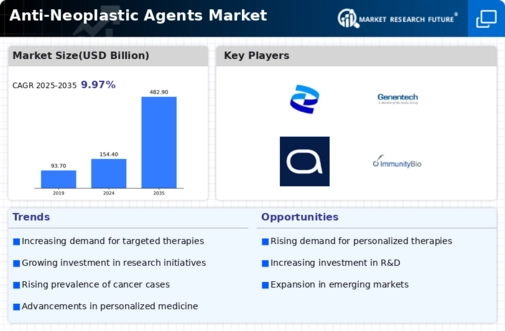Market Growth Projections
The Global Anti-Neoplastic Agents Market Industry is poised for substantial growth, with projections indicating a rise from 154.4 USD Billion in 2024 to 482.9 USD Billion by 2035. This remarkable increase highlights the escalating demand for anti-neoplastic therapies as the global cancer burden intensifies. The anticipated CAGR of 10.92% for the period from 2025 to 2035 reflects the industry's potential to innovate and adapt to emerging challenges in cancer treatment. As new therapies are developed and approved, the market is likely to witness a surge in investment and research, further solidifying its position as a critical component of global healthcare.
Rising Incidence of Cancer
The increasing prevalence of cancer worldwide serves as a primary driver for the Global Anti-Neoplastic Agents Market Industry. According to the World Health Organization, cancer cases are projected to rise significantly, with estimates suggesting that by 2035, the number of new cancer cases could reach 24 million annually. This alarming trend necessitates the development and availability of effective anti-neoplastic agents, which are crucial for treatment. As the market is expected to grow from 154.4 USD Billion in 2024 to 482.9 USD Billion by 2035, the demand for innovative therapies will likely continue to escalate, further propelling market growth.
Advancements in Drug Development
Innovations in drug development methodologies, including targeted therapies and immunotherapy, are transforming the landscape of cancer treatment. The Global Anti-Neoplastic Agents Market Industry benefits from these advancements, as they lead to the introduction of more effective and personalized treatment options. For instance, the development of monoclonal antibodies and CAR T-cell therapies has shown promising results in clinical trials, enhancing patient outcomes. As the market is projected to grow at a CAGR of 10.92% from 2025 to 2035, the continuous evolution of drug development processes is likely to play a pivotal role in meeting the increasing demand for anti-neoplastic agents.
Government Initiatives and Funding
Government initiatives aimed at combating cancer significantly influence the Global Anti-Neoplastic Agents Market Industry. Various countries have implemented national cancer control programs, which include funding for research and development of anti-neoplastic agents. For example, the National Cancer Institute in the United States allocates substantial resources to cancer research, fostering innovation in treatment options. Such initiatives not only enhance the availability of new therapies but also stimulate market growth. As the industry expands, the financial support from governments is expected to facilitate the development of novel anti-neoplastic agents, thereby addressing the rising global cancer burden.
Emerging Markets and Global Expansion
The expansion of the Global Anti-Neoplastic Agents Market Industry into emerging markets presents a significant growth opportunity. Countries in Asia-Pacific and Latin America are experiencing rising cancer rates, coupled with improving healthcare infrastructure and access to treatment. As these regions invest in healthcare systems, the demand for anti-neoplastic agents is expected to surge. This trend is supported by the projected CAGR of 10.92% from 2025 to 2035, indicating robust growth potential. Pharmaceutical companies are increasingly focusing on these markets, recognizing the need for effective cancer therapies, which could lead to a more equitable distribution of treatment options globally.
Increasing Awareness and Screening Programs
Heightened awareness regarding cancer prevention and early detection is driving the demand for anti-neoplastic agents within the Global Anti-Neoplastic Agents Market Industry. Public health campaigns and screening programs have led to earlier diagnoses, which in turn necessitate timely treatment with effective anti-neoplastic therapies. For instance, initiatives promoting mammography and colonoscopy have resulted in increased detection rates of breast and colorectal cancers. This growing emphasis on early intervention is likely to contribute to market expansion, as patients seek advanced treatment options. The anticipated growth from 154.4 USD Billion in 2024 to 482.9 USD Billion by 2035 underscores the importance of these awareness efforts.















Leave a Comment